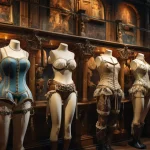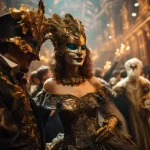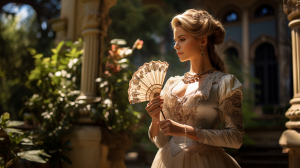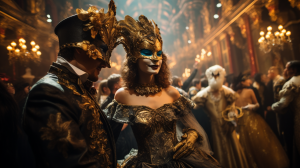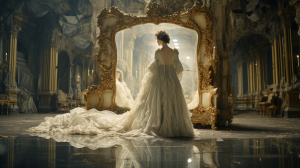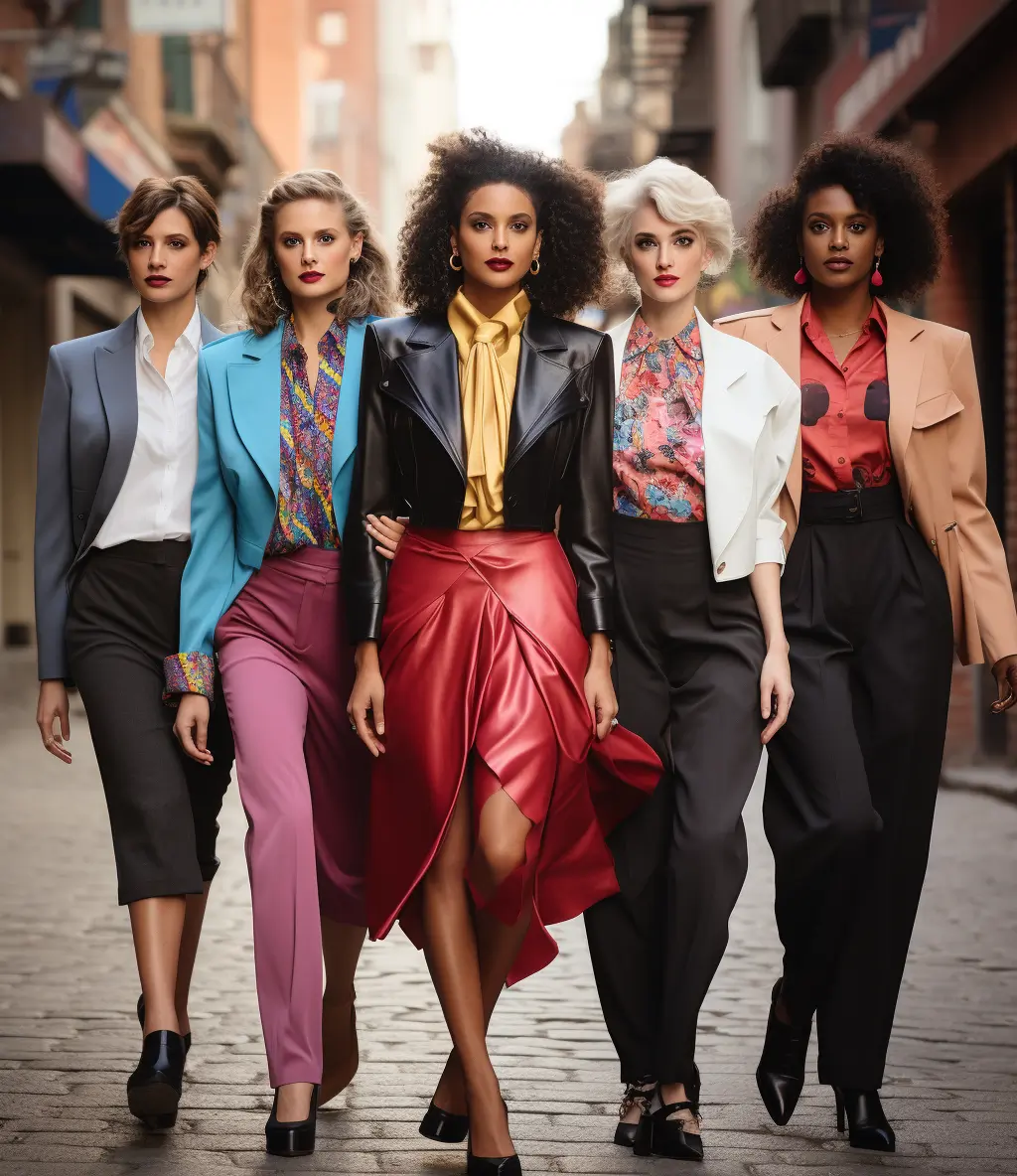
The Bold and Brash: Exploring 1980s Power Dressing
The Rise of 1980s Power Dressing
In the dazzling decade that was the 1980s, power dressing emerged as a formidable force in the world of fashion. It wasn’t just about clothes; it was a statement, a symbol of ambition, and a reflection of the times. Let’s journey back to an era where the world was changing rapidly, and fashion followed suit.
The 1980s was a pivotal period marked by political upheaval, economic shifts, and social transformations. As the world grappled with these changes, fashion responded with a trend that would become synonymous with the era: power dressing. It was more than just a style; it was an attitude, a visual representation of confidence and authority.
Bold Colors and Confidence
In this electrifying chapter of fashion history, bold colors took center stage. Neon and vibrant hues became the palette of empowerment. Picture a world where electric pinks, vibrant blues, and eye-searing yellows were not just fashion choices but statements of self-assuredness.
These daring colors were more than just a fashion preference; they were a reflection of the spirit of the times. The ’80s were marked by a sense of optimism, and these hues captured that exuberance perfectly. When you think of power dressing in the 1980s, imagine a landscape awash in vivid shades, with individuals exuding an unapologetic air of confidence.
Shoulder Pads: The Iconic Silhouette
To truly understand the essence of power dressing in the 1980s, one must acknowledge the dramatic shoulders. Imagine sharp-shouldered suits and blazers that seemed to defy gravity, creating an unmistakable silhouette. This distinctive feature was no mere fashion trend; it was a visual representation of strength.
The shoulder pads of the ’80s were not subtle. They were bold, pronounced, and impossible to ignore. They broadened shoulders, providing an illusion of authority and dominance. These pads weren’t just stitched into garments; they were woven into the fabric of the era itself.
Tailored Suits: The Power Suit Phenomenon
Now, envision the power suit—a tailored masterpiece that became a symbol of empowerment and independence. The power suit transcended gender norms, as women embraced the structured elegance of their male counterparts. It was a powerful statement that challenged traditional notions of femininity.
These suits were impeccably tailored, emphasizing sharp lines, structured silhouettes, and assertive style. They represented a fusion of strength and sophistication, a sartorial embodiment of ambition. In a world undergoing rapid change, the power suit became a visual emblem of women’s rising influence and the breaking of barriers.
As we journey further into the world of 1980s power dressing, we’ll explore how these elements came together to create a fashion phenomenon that left an indelible mark on history.

Image a dynamic collage of images from the 1980s, showcasing bold and vibrant colors that demand attention. The central focus is on tailored suits with exaggerated shoulder pads, creating a powerful and confident silhouette. The image radiates an aura of ambition and self-assuredness, capturing the essence of 1980s power dressing.
The 1980s: A Bold Era in Every Aspect
In the 1980s, the world was pulsating with a unique energy. It was an era of larger-than-life characters, dramatic changes, and a society in constant flux. To truly understand the rise of power dressing during this tumultuous decade, we need to dive into the societal and political maelstrom that provided the backdrop for this audacious fashion movement.
A Chaotic Stage: Societal and Political Backdrop
The 1980s was a time when the world seemed to teeter between extremes. On one hand, there was an air of optimism, fueled by technological advancements and the end of the Cold War. On the other, it was a period marred by economic challenges, political conflicts, and shifting global dynamics.
Picture the world stage: The Cold War was thawing, and the Berlin Wall eventually fell, symbolizing a seismic shift in global politics. Simultaneously, economic struggles led to a sense of uncertainty, affecting individuals’ lives in profound ways. The ’80s was an era where contrasting forces clashed, giving rise to a complex and often contradictory environment.
A Reaction to Turbulence: Emergence of Power Dressing
Amidst this turbulence, power dressing emerged as a poignant response to the challenges of the time. As the world grappled with economic fluctuations and political transformations, individuals sought to regain control over their lives, both personally and professionally.
Imagine a generation that refused to be defined by external circumstances. Power dressing became a tool for individuals to project confidence and assertiveness, regardless of the chaos around them. It was a declaration of resilience, a way to reclaim power in an uncertain world.
Influential Figures and Celebrities: Setting the Stage
Power dressing wasn’t just a trend; it was a movement championed by influential figures and celebrities. Think of charismatic leaders, politicians, and entertainers who not only embraced power dressing but also used it to convey authority and charisma.
Visualize prominent figures like Ronald Reagan and Margaret Thatcher, exuding confidence in tailored suits and commanding attention on the global stage. Celebrities like Madonna and Michael Jackson made power dressing a part of their iconic personas, influencing millions with their style choices.
As we navigate through this era, we’ll explore how these figures and their fashion choices played a pivotal role in shaping the narrative of 1980s power dressing.
Image Description:
Picture a bustling urban scene from the 1980s, where powerful individuals, both on the global stage and in everyday life, are dressed in sharp, tailored suits and bold, vibrant colors. The atmosphere is charged with a sense of determination and resilience. This single scene captures the essence of the era’s power dressing trend, where individuals stood tall against a backdrop of societal and political turbulence.
Bold Colors and Confidence
Neon and Vibrant Hues
Alright, folks, let’s dive deep into the electric waters of neon and vibrant hues that defined the 1980s. This subcategory takes us to a world where color wasn’t just a choice—it was a statement. Imagine a time when walking down the street felt like stepping into a neon-lit wonderland.
A Riot of Colors: The Popularity of Neon
Picture this: Streets and clubs bathed in a neon glow, as if the entire world had turned up the saturation dial. Neon colors like blazing pinks, electric greens, and dazzling oranges dominated the fashion scene. It wasn’t just about standing out; it was about making a bold, unforgettable impression.
Neon colors were a visual representation of the era’s audacity. People weren’t afraid to be seen, and their clothing choices reflected this fearless attitude. Neon wasn’t just a color; it was an exclamation mark in the language of fashion.
Confidence Beyond Conformity
Now, let’s talk about what those neon hues represented: confidence and assertiveness. Think about how it felt to wear something that practically screamed for attention. It wasn’t about blending in; it was about owning the moment.
Imagine individuals striding down the street, their neon outfits illuminating the urban landscape like neon signs in the night. These colors were a proclamation of self-assuredness. In a world where conformity often reigned, neon wearers were rebels, unapologetically celebrating their individuality.
As we journey further into the neon-lit ’80s, remember that fashion wasn’t just about looking good; it was about feeling good and making a statement. Neon was the language, and confidence was the message.
Image Description:
Picture a bustling 1980s urban street, bathed in the vivid glow of neon lights. Individuals, dressed in neon attire, confidently walk amidst the vibrant colors. The scene radiates a sense of boldness and self-assuredness, capturing the essence of the era’s neon fashion trend.
Shoulder Pads: The Iconic Silhouette
Dramatic Shoulders
Alright, now, folks, let’s talk about a fashion statement that quite literally broadened horizons—the iconic shoulder pads. These weren’t just pads; they were architectural marvels that transformed silhouettes and oozed authority. Picture yourself in the 1980s, where shoulders were square and confidence was high.
The Pinnacle of Power: Prominence of Shoulder Pads
Imagine a world where sharp angles and structured lines ruled the day. Shoulder pads were the crown jewel of this trend. They weren’t there for comfort; they were there to make a statement. Fashionistas and corporate warriors alike embraced these bold additions to their wardrobes.
Shoulder pads weren’t just a minor detail; they were the focal point of many outfits. They elevated blazers, jackets, and dresses to new heights—literally. These pads created a silhouette that commanded attention and respect. It wasn’t about blending in; it was about standing tall and proud.
Transforming Silhouettes: From Soft to Structural
Now, let’s get into the nitty-gritty. Imagine the transformation happening as these shoulder pads slid into clothing. Suddenly, the soft, natural curves of the body gave way to bold, angular lines. The silhouette went from fluid to structured, from approachable to authoritative.
People wore their ambitions on their shoulders, quite literally. This fashion phenomenon didn’t just change the way people looked; it changed the way they felt. Shoulders squared, and heads held high, individuals strutted with an air of self-assuredness.
In the corporate world, these dramatic shoulders were like armor, instilling confidence in boardrooms and office corridors. In social settings, they made a powerful statement, conveying that the wearer was unapologetically in charge of their destiny.
As we delve deeper into the realm of dramatic shoulders, remember that in the 1980s, fashion wasn’t just about clothing; it was about empowerment and self-expression.
Image Description:
Picture a scene where a confident individual stands tall, their shoulders adorned with exaggerated shoulder pads. The image exudes a sense of boldness and authority as the shoulders create a striking, structured silhouette. This single scene captures the essence of the ’80s shoulder pad trend, where confidence met fashion in dramatic fashion.
Tailored Suits: The Power Suit Phenomenon
Gender and Fashion
Now, we venture into a territory where fashion had more to say than just a statement—it had a whole conversation. The power suit phenomenon of the 1980s shattered traditional norms, challenging gender dynamics, and pushing the boundaries of what was possible. Buckle up; it’s going to be a fascinating ride.
The Bold Move: Gender and Fashion Clash
Imagine a world where clothing wasn’t just a matter of personal style; it was a battlefield for equality. The ’80s were marked by a significant shift in gender dynamics. Women were breaking free from the confines of traditional roles and asserting themselves in various domains, including the workplace.
Picture this: Women in tailored suits, with shoulder pads that rivaled their male counterparts, striding into boardrooms and offices with confidence and authority. It was a visual testament to their determination to be taken seriously in a world where the corporate landscape was predominantly male.
Challenging Norms: The Power Suit’s Impact
Now, let’s talk about the power of the power suit. These tailored ensembles were more than just fashion statements; they were symbols of empowerment. The structured lines and assertive style defied the traditional notions of femininity. Women were embracing clothing that was previously reserved for men.
Visualize a world where power suits became a canvas for women to express themselves. They weren’t just imitating men; they were redefining what it meant to be a powerful woman. It was a declaration that they could be strong, ambitious, and stylish all at once.
As we continue our exploration into gender and fashion in the 1980s, remember that power dressing wasn’t just about clothes; it was about challenging societal norms and pushing the boundaries of what was acceptable.
Image Description:
Envision an iconic ’80s scene where a confident woman dons a perfectly tailored power suit, complete with sharp shoulders and bold lines. She stands tall, a symbol of empowerment, in a world where traditional gender roles are being rewritten. This single scene encapsulates the essence of the power suit phenomenon, where fashion became a powerful tool for change and self-expression.
Fashion Icons of the 1980s
Celebrity Style Icons
Alright, let’s take a moment to pay homage to the trailblazers, the trendsetters, and the icons who defined fashion in the 1980s. In this subcategory, we’re diving deep into the world of celebrity style icons, where their fashion choices were like brushstrokes on the canvas of an era.
Elegance Meets Boldness: Influential Figures
Picture an era where fashion was not just about what you wore but who you were. Celebrities became more than just entertainers; they became cultural influencers who left an indelible mark on the fashion landscape. Names like Joan Collins, Melanie Griffith, and countless others come to mind.
These influential figures weren’t just celebrities; they were style icons. They embodied the essence of the ’80s power dressing trend, both on and off the screen. Their choices in clothing reflected not just personal style but also the zeitgeist of the era.
Joan Collins: The Epitome of Glamour
Imagine the epitome of Hollywood glamour in the ’80s, and Joan Collins comes to mind. Her role as Alexis Carrington in the TV series “Dynasty” not only made her a household name but also an icon of opulence and extravagance. Collins exuded confidence in her sharp-shouldered power suits, setting the standard for fierce femininity.
Melanie Griffith: Rebel with a Cause
Now, let’s talk about Melanie Griffith. She embodied the rebellious spirit of the 1980s, both on and off-screen. Her roles in films like “Working Girl” showcased a unique blend of grit and glamour. Griffith’s fashion choices were a reflection of her characters—daring, ambitious, and unapologetically bold.
As we celebrate these celebrity style icons, remember that they weren’t just fashion plates; they were pioneers who helped shape the fashion narrative of the 1980s. Their choices spoke volumes about the era’s desire for empowerment, individuality, and self-expression.
Image Description:
Imagine a vibrant ’80s scene where Joan Collins and Melanie Griffith stand side by side. Collins exudes glamour in a sharp-shouldered power suit, while Griffith radiates rebellion with her bold fashion choices. This single scene captures the essence of celebrity style icons who left an indelible mark on the era, where fashion and personality converged to create iconic moments.
Corporate Culture and Power Dressing
Workplace Fashion
Alright, let’s put on our power suits and step into the world of corporate culture in the 1980s. This subcategory is all about how power dressing influenced the way people dressed for success in the professional arena and how it played a pivotal role in reshaping women’s roles in the workplace.
Where Business Meets Fashion: Influence of Power Dressing
Visualize a corporate landscape in the 1980s, where the power suit was more than just a uniform; it was a statement of ambition and authority. In the workplace, power dressing became the armor of choice for those looking to climb the corporate ladder.
Imagine a bustling office where employees, regardless of gender, embraced tailored suits, sharp shoulders, and bold colors. These outfits weren’t just about adhering to a dress code; they were about projecting an image of competence and confidence. Power dressing was the sartorial bridge that connected fashion with corporate success.
Empowerment Through Attire: Impact on Women’s Roles
Now, let’s focus on a significant aspect of this transformation—the impact of power dressing on women’s roles in the workplace. Picture a time when women were increasingly entering male-dominated fields, breaking through glass ceilings, and demanding equal recognition.
Power dressing played a pivotal role in this shift. Women adopted the power suit as a symbol of their aspirations and capabilities. Shoulder pads became more than a fashion choice; they were symbols of strength. Women in the corporate world were saying, “I’m here, I’m capable, and I’m dressed for success.”
As we explore workplace fashion in the 1980s, remember that power dressing wasn’t just about clothes; it was about empowerment and breaking barriers, one sharp shoulder at a time.
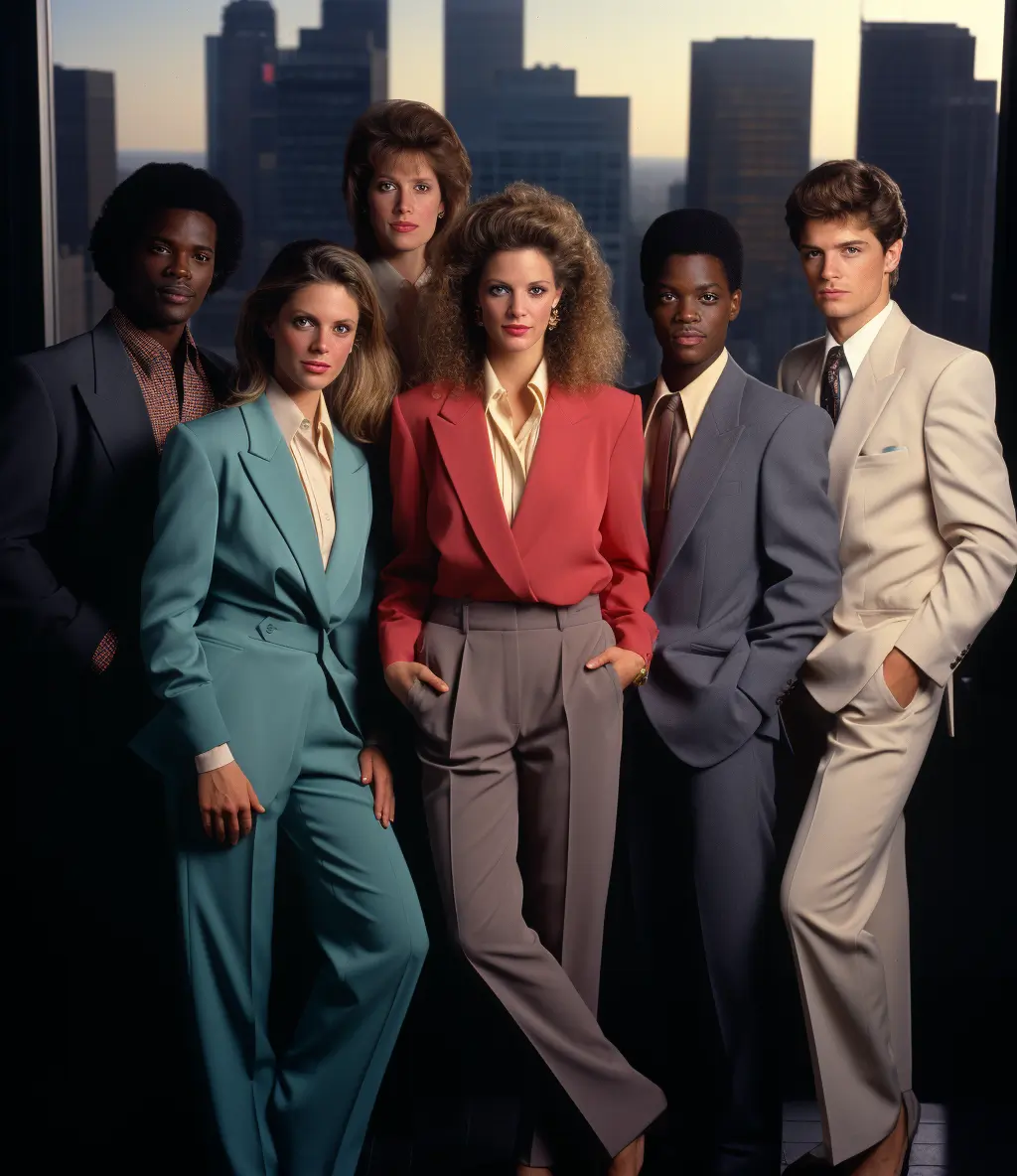
Image Envision an ’80s office scene where individuals, regardless of gender, are dressed in power suits. The atmosphere exudes a sense of professionalism and ambition, with strong, confident postures. This single scene captures the essence of power dressing’s influence on corporate culture, where attire became a tool for empowerment and success in the workplace.
The Legacy of 1980s Power Dressing
Modern Interpretations
Alright, let’s fast-forward to today and examine how the bold, audacious spirit of 1980s power dressing has left an indelible mark on modern fashion. In this subcategory, we’ll explore how elements of this trend persist, finding new life and relevance in the ever-evolving world of style.
From Past to Present: Elements That Endure
Imagine a fashion landscape where history isn’t confined to the past. Elements of power dressing from the 1980s continue to captivate designers, fashion enthusiasts, and individuals who crave a taste of that audacious era. The ’80s left an unmistakable imprint on the fashion DNA of today.
Visualize sharp shoulders, tailored silhouettes, and bold colors making a comeback on modern runways. It’s as if the ’80s left behind a treasure trove of inspiration for contemporary designers to explore. These elements persist because they resonate with the desire for confidence, empowerment, and self-expression.
Reinvention and Relevance: Power Dressing Today
Now, let’s talk about how power dressing has evolved and stayed relevant. Picture a world where individuals are no longer confined by traditional notions of fashion. Today, power dressing isn’t just about emulating the past; it’s about reinventing it.
Imagine a fashion-savvy generation that takes the elements of power dressing and fuses them with their own unique style. It’s a world where power isn’t confined to the boardroom but is found in everyday life. Modern interpretations of power dressing show that confidence and assertiveness are timeless.
As we conclude our exploration of 1980s power dressing, remember that fashion has a way of reinventing itself while paying homage to its roots. The legacy of this trend is not just in the past; it’s alive and thriving in the present, and who knows where it will take us in the future.
Image Description:
Visualize a contemporary city scene where individuals confidently stride through bustling streets, showcasing modern interpretations of 1980s power dressing. The scene exudes a sense of style, empowerment, and individuality, capturing the enduring legacy of this trend in the fashion landscape.
Pop Culture References
Movies and TV Shows
Alright, folks, let’s take a cinematic trip down memory lane and see how 1980s power dressing has made its mark in popular culture. In this subcategory, we’ll explore how the trend found its way into the world of movies and TV shows, leaving us with iconic characters who personify power dressing.
Celluloid Icons: Depicting 1980s Power Dressing
Imagine sitting in a darkened theater or lounging on your couch, watching characters who embody the essence of the ’80s power dressing trend. It’s not just about costumes; it’s about characters who wear their confidence like a badge of honor.
Visualize iconic movie characters like Gordon Gekko from “Wall Street,” who epitomized corporate ruthlessness and sharp power dressing. His slicked-back hair, tailored suits, and commanding presence were a visual testament to the era’s ethos.
TV’s Power Players: Iconic Characters
Now, shift your gaze to the small screen, where TV shows brought us characters who made their mark. Picture the indomitable Alexis Carrington from “Dynasty.” Her extravagant wardrobe and larger-than-life personality made her a style icon of opulence and extravagance.
In the realm of sitcoms, consider the character of Angela Bower from “Who’s the Boss?” Her journey from casual housekeeper to a high-powered advertising executive showcased the transformative power of a well-tailored power suit.
As we explore pop culture references, remember that these characters weren’t just fictional; they represented the aspirations and ideals of an era. They embodied the essence of power dressing, leaving an indelible mark on our collective memory.
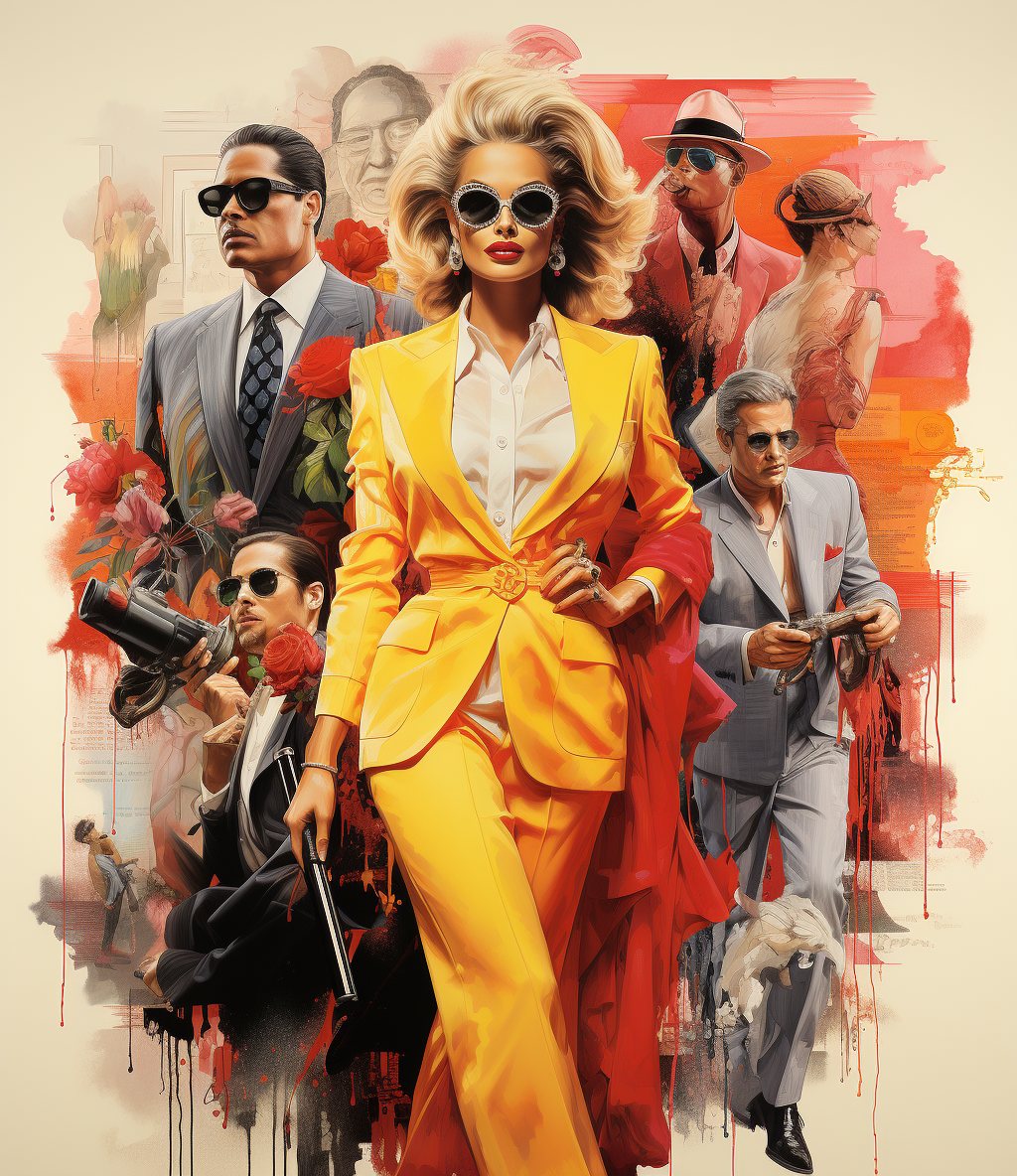
Image a collage of iconic movie and TV characters from the 1980s, each exuding their unique style and confidence through power dressing. From Gordon Gekko’s sharp suits to Alexis Carrington’s opulent attire, the image captures the diverse representations of the trend in popular culture.
Cultural Significance: Beyond Fashion
Feminism and Empowerment
Alright, we’re diving deep into the cultural undercurrents of 1980s power dressing, specifically its connection to feminism and empowerment. In this subcategory, we’ll explore how power dressing transcended fashion to become a symbol of empowerment and agency for women.
Fashion as a Manifestation of Empowerment
Picture a society in transition, where women were no longer content with playing secondary roles. The 1980s marked a pivotal moment in the feminist movement, and fashion played an unexpected but significant role in this narrative.
Visualize women confidently donning power suits, inspired by the likes of Joan Collins and Melanie Griffith. These were not just garments; they were statements of intent. Power dressing allowed women to project authority and assertiveness, challenging traditional gender norms.
Symbol of Empowerment: The Power Suit as Armor
Now, let’s talk about how the power suit became a symbol of empowerment. Imagine individuals, regardless of their gender, embracing this trend as a means of self-expression and self-assurance. It wasn’t about conformity; it was about choice and agency.
Picture a scene where women in the corporate world proudly wore power suits, signaling that they were equal participants in the professional arena. The structured shoulders and tailored ensembles became a kind of armor, shielding them from gender biases and outdated stereotypes.
As we delve into the feminist aspects of power dressing, remember that fashion is more than just fabric; it’s a canvas for self-expression, empowerment, and challenging societal norms.
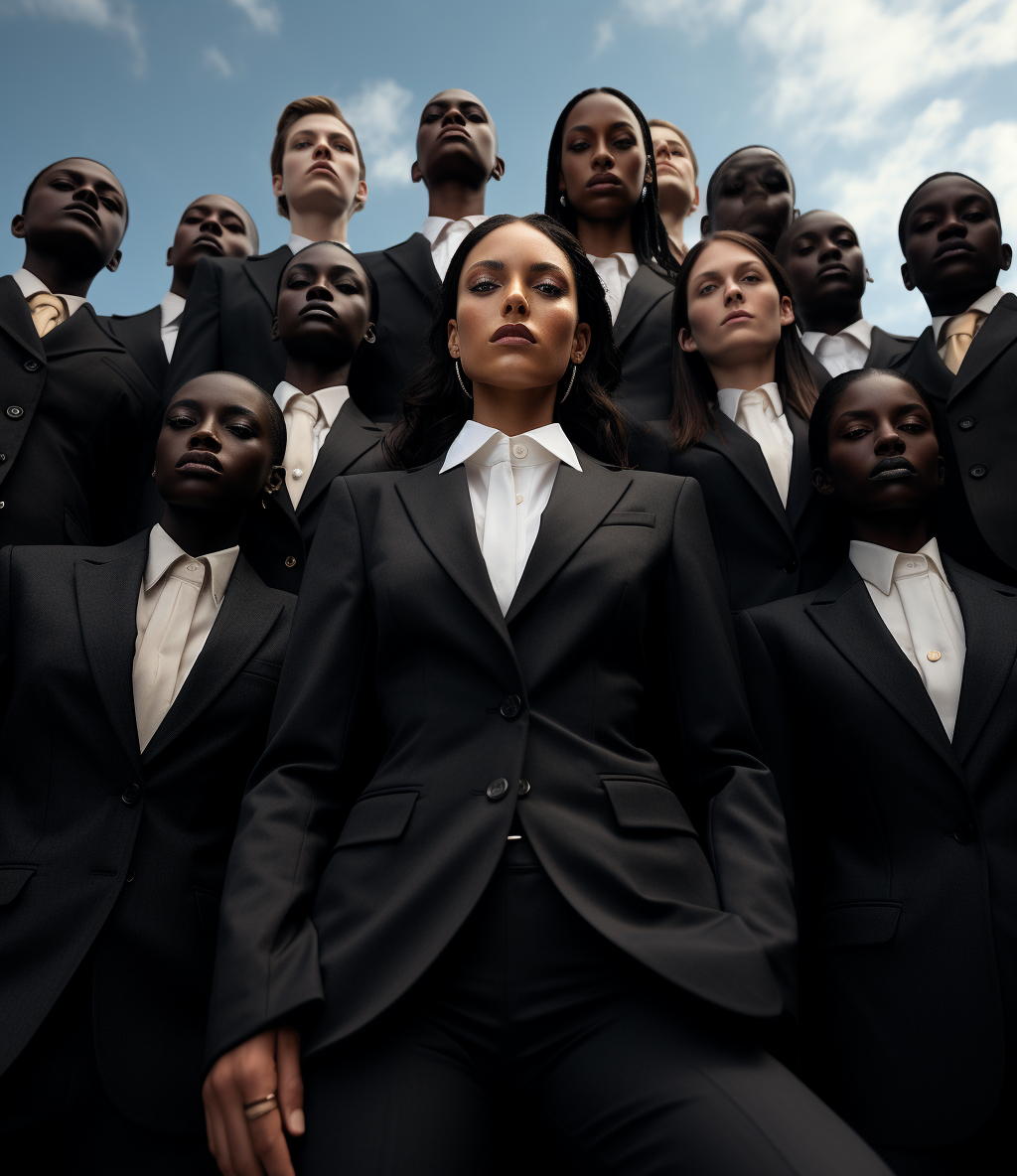
Image a powerful scene where a diverse group of individuals, representing various backgrounds and genders, confidently wears power suits. Their posture exudes strength and determination, symbolizing empowerment and agency. This single scene captures the essence of power dressing as a cultural phenomenon that transcended fashion, making a statement about equality and self-expression.
Conclusion
Alright, we’ve traveled through time, explored fashion’s journey through the 1980s, and dissected the cultural tapestry of power dressing. It’s time to wrap it all up and leave you with some food for thought—though we’re not talking about food today.
A Fashion Journey Through Time
In this deep dive into 1980s power dressing, we’ve witnessed the rise of bold shoulders, the resurgence of tailored suits, and the empowerment of individuals, especially women, through fashion. This trend wasn’t just about clothing; it was about self-expression, empowerment, and challenging societal norms.
The Unforgettable Legacy
Power dressing of the ’80s wasn’t a fleeting trend; it left a lasting legacy. Elements of this era continue to inspire contemporary fashion, showing us that confidence, self-expression, and empowerment are timeless.
A Call to Action
So, as we conclude this fashion journey, here’s a call to action. Let’s not forget the lessons from this era. Fashion has the power to transcend clothing; it can reflect our values, challenge norms, and empower us. Whether it’s the boldness of neon colors, the authority of structured shoulders, or the courage to break free from tradition, let’s carry the spirit of power dressing forward in our own unique ways.
Remember, fashion isn’t just about what you wear; it’s about how you wear it and what it says about who you are. So, go ahead, embrace your power, and make your fashion statement.
Image Description:
Imagine a dynamic scene where a diverse group of individuals, dressed in a blend of ’80s power dressing and modern interpretations, stand together with confidence. The image symbolizes the enduring legacy of this trend, reminding us that fashion is a powerful tool for self-expression and empowerment.



